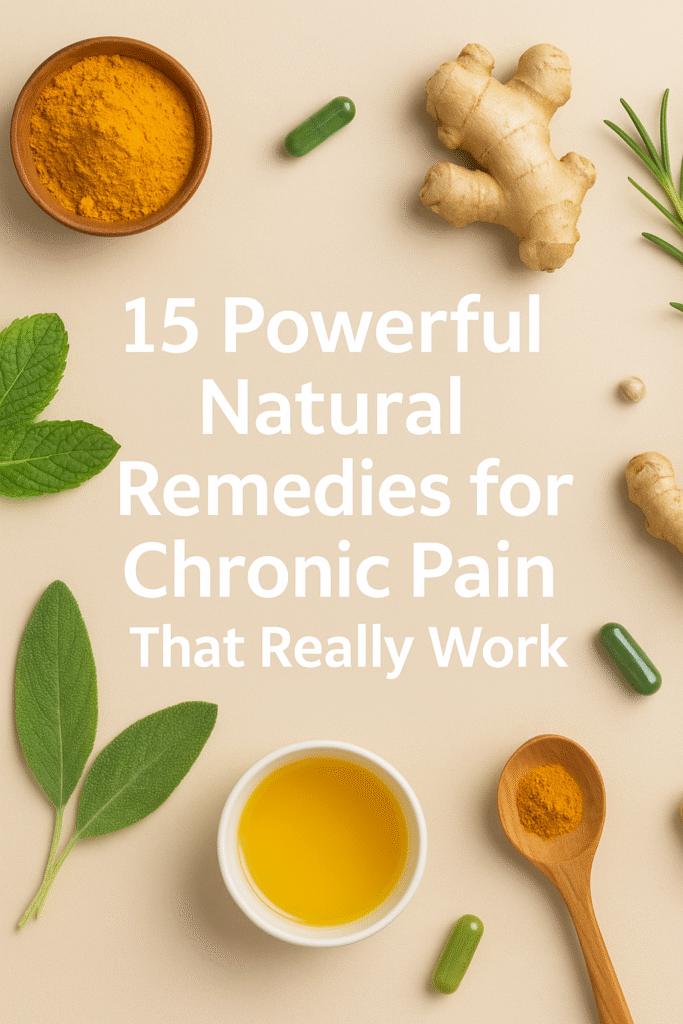
⚠️ Affiliate Disclaimer: This post may contain affiliate links, which means I may earn a small commission — at no extra cost to you — if you make a purchase through one of these links. I only recommend products or services I genuinely trust and believe can provide value. Thank you for supporting My Medical Muse!
15 Powerful Natural Remedies for Chronic Pain That Really Work
15 Powerful Natural Remedies for Chronic Pain That Really Work
Chronic pain is not simply a minor inconvenience,it’s a complex, long-term health condition that can interfere with movement, disrupt sleep, impair focus, and significantly reduce quality of life. For millions worldwide, this pain persists for months or even years, often despite medical interventions.
While prescription and over-the-counter medications can provide relief, they may come with side effects such as drowsiness, digestive issues, or dependency risks. This has driven many people to explore natural remedies safe, evidence-based alternatives that can complement conventional care and, in some cases, reduce reliance on medication.
In this guide, we break down 15 proven natural approaches from anti-inflammatory herbs and targeted nutrition to physical therapies and mind-body practices that have shown measurable benefits for chronic pain management. Each method is supported by research and practical application, making it easier to find strategies that fit your lifestyle and health needs.
Understanding Chronic Pain
Chronic pain is more than just prolonged discomfort, it is a medical condition in its own right. It is generally defined as pain that persists for three months or longer, even when the initial injury, illness, or tissue damage has healed. Unlike acute pain, which is a short-term warning signal that something is wrong, chronic pain can linger without an obvious cause or may be disproportionate to the original trigger.
This persistence is often due to changes in the nervous system. Over time, the brain and spinal cord can become more sensitive to pain signals, a phenomenon known as central sensitization. This means that even mild stimuli such as light touch or small movements can be perceived as painful.
Common underlying causes of chronic pain include:
- Arthritis and other joint conditions: such as osteoarthritis or rheumatoid arthritis, which cause ongoing inflammation and stiffness.
- Fibromyalgia: a disorder involving widespread muscle pain, fatigue, and tenderness in specific points of the body.
- Back and neck injuries: including herniated discs, spinal stenosis, or whiplash, which can lead to nerve irritation or long-term muscle strain.
- Nerve damage (neuropathy): often caused by diabetes, shingles, or traumatic injuries.
- Migraines and chronic headaches: which can stem from vascular changes, nerve dysfunction, or hormonal imbalances.
The impact goes far beyond physical discomfort. Chronic pain can disrupt sleep cycles, limit mobility, and lead to emotional and psychological challenges such as:
- Depression and anxiety: stemming from constant discomfort and reduced ability to engage in normal activities.
- Fatigue: due to both the pain itself and the energy the body uses to cope with it.
- Cognitive difficulties (“brain fog”): where pain interferes with concentration and memory.
Because chronic pain affects both body and mind, a purely medical approach such as relying solely on prescription painkillers often falls short. This is why many experts now recommend a holistic, whole-body strategy that combines medical treatments with natural remedies, lifestyle changes, and psychological support to address both the symptoms and their underlying drivers.
Why Choose Natural Remedies?
Conventional pain medications whether over-the-counter anti-inflammatories or prescription opioids can be effective in reducing discomfort, but they often come with limitations and potential drawbacks. Side effects like drowsiness, digestive irritation, dizziness, or even dependency can make long-term use problematic. In addition, medication typically focuses on masking symptoms rather than addressing the root causes of pain.
Natural remedies provide a valuable alternative or complement to medical treatment for several reasons:
- Fewer side effects when used correctly: Herbal remedies, targeted nutrition, and physical therapies are generally well-tolerated, especially when introduced gradually and under professional guidance.
- Holistic, whole-body approach: Many natural treatments support overall wellness, addressing not just pain but also stress, inflammation, circulation, and mental well-being.
- Compatibility with conventional care: Natural methods can be safely integrated with prescribed therapies, allowing for a multimodal approach that maximizes results.
- Root-cause targeting: Certain remedies work to reduce inflammation, relieve muscle tension, improve joint flexibility, or restore nerve function, tackling the source of pain instead of just numbing it.
For many, the shift to natural remedies is not about rejecting modern medicine, but about enhancing it with sustainable, evidence-based practices that support long-term health.
Herbal Remedies for Chronic Pain
Nature has long provided powerful compounds capable of reducing pain, calming inflammation, and promoting tissue repair. The following five herbal and plant-based treatments are among the most researched and widely used for chronic pain relief.
a. Turmeric (Curcumin)
Turmeric, a golden-yellow spice, contains curcumin, a bioactive compound with strong anti-inflammatory and antioxidant properties. Research shows curcumin can reduce swelling, stiffness, and discomfort in conditions such as osteoarthritis and rheumatoid arthritis.
- How to use: Add turmeric powder to soups, curries, or smoothies; brew turmeric tea; or take standardized curcumin supplements.
Combine with black pepper (piperine) to increase curcumin absorption by up to 2000%.
b. Ginger
Ginger is another potent anti-inflammatory herb that helps reduce muscle soreness, stiffness, and joint discomfort. It is especially effective in easing pain from osteoarthritis and exercise-induced muscle strain.
- How to use: Brew fresh ginger tea, add grated ginger to cooking, or use powdered ginger in smoothies. Capsules are available for consistent dosing.
c. Willow Bark
- Willow bark has been used for centuries as a natural pain reliever thanks to salicin, a chemical similar to the active ingredient in aspirin. It is particularly effective for back pain, osteoarthritis, and muscle aches.
Caution: Avoid if allergic to aspirin, if you have certain bleeding disorders, or if you are taking blood-thinning medications. Always consult a healthcare professional first.
d. Boswellia (Frankincense)
Boswellia serrata, commonly known as frankincense, is valued in Ayurvedic medicine for its boswellic acids, which can inhibit inflammation and reduce cartilage breakdown in joints. Studies suggest it may help with rheumatoid arthritis and inflammatory bowel disease-related pain.
- How to use: Available as capsules, tablets, or topical creams. Consistency is key, as benefits build over several weeks.
e. Capsaicin Cream
Capsaicin, the compound that gives chili peppers their heat, works by temporarily blocking pain signals sent through the nerves. It is often used for arthritis, nerve pain (neuropathy), and muscle aches.
- Best for: Localized pain in joints, muscles, or nerves.
- Note: Initial application may cause a warm or burning sensation this usually lessens with continued use. Avoid contact with eyes or mucous membranes.
Dietary & Nutritional Approaches
What you eat plays a direct role in inflammation levels, tissue repair, and nerve health. Adopting an anti-inflammatory diet can significantly reduce the intensity and frequency of chronic pain.
1. Anti-inflammatory Diet
An anti-inflammatory diet focuses on nutrient-rich foods that naturally calm inflammation and support healing.
Eat more:
- Fatty fish (salmon, sardines, mackerel): rich in omega-3 fatty acids that reduce inflammatory markers in the body.
- Leafy greens (spinach, kale, Swiss chard): high in antioxidants and magnesium.
- Berries (blueberries, strawberries, blackberries): packed with anthocyanins that help fight oxidative stress.
- Nuts and seeds (walnuts, flaxseeds, chia seeds): sources of healthy fats and protein.
- Olive oil: contains oleocanthal, a compound with natural anti-inflammatory effects.
- Fatty fish (salmon, sardines, mackerel): rich in omega-3 fatty acids that reduce inflammatory markers in the body.
Avoid:
- Processed sugar: spikes inflammation and contributes to weight gain.
- Refined carbs (white bread, pastries): linked to increased joint inflammation.
- Trans fats: found in fried foods, margarine, and packaged snacks, which can worsen joint pain and cardiovascular risk.
- Processed sugar: spikes inflammation and contributes to weight gain.
2. Hydration
Dehydration can make joints feel stiffer and muscles more prone to cramping. Adequate fluid intake keeps cartilage lubricated, helps flush out toxins, and supports cellular repair.
Aim for 2-3 liters of water daily, adjusting for climate and activity level. Herbal teas and water-rich fruits like watermelon and cucumber can also contribute to hydration.
Physical Therapies & Bodywork
Movement and manual therapies are essential for managing chronic pain. They help reduce stiffness, improve posture, and stimulate natural pain-relief mechanisms in the body.
Massage Therapy
Massage improves blood flow, reduces muscle tension, and encourages the release of endorphins, the body’s natural painkillers. Regular sessions can help with conditions like fibromyalgia, back pain, and arthritis.
Chiropractic Care
Through spinal adjustments and manipulation, chiropractic treatments can restore proper alignment, relieve nerve compression, and improve mobility, especially in cases of back and neck pain.
Acupuncture
This traditional Chinese medicine practice uses thin needles to stimulate specific points on the body. Research suggests it may trigger the release of endorphins and alter nerve signal processing, reducing pain perception.
Stretching & Gentle Exercises
Low-impact activities such as yoga, tai chi, and Pilates increase flexibility, strengthen muscles, and improve balance without placing excessive strain on joints or soft tissues.
Mind-Body Techniques
Chronic pain isn’t only physical, it’s also influenced by the brain’s interpretation of pain signals. Mind-body techniques can help break the cycle of pain, stress, and muscle tension.
- Meditation & Mindfulness: Mindfulness-based stress reduction (MBSR) programs teach individuals to observe their pain without judgment, reducing its emotional impact and helping lower inflammatory stress hormones.
- Breathing Exercises: Slow, deep breathing activates the parasympathetic nervous system, promoting relaxation and lowering muscle tension. Techniques like diaphragmatic breathing can be practiced anywhere.
- Cognitive Behavioral Therapy (CBT): CBT is a structured form of talk therapy that helps reframe negative thought patterns, teaches coping strategies, and improves mental resilience in the face of ongoing pain.
Heat and Cold Therapy
Temperature-based therapies can be powerful, inexpensive tools for immediate relief.
Heat therapy:
- Ideal for stiffness, muscle tightness, or chronic conditions.
- Works by increasing blood flow, relaxing soft tissues, and reducing joint stiffness.
- Common methods: heating pads, warm baths, or heat wraps.
- Ideal for stiffness, muscle tightness, or chronic conditions.
Cold therapy:
- Best for acute inflammation, swelling, or sharp pain.
- Works by constricting blood vessels, reducing fluid buildup, and numbing nerve endings.
- Common methods: ice packs, cold compresses, or ice baths.
- Best for acute inflammation, swelling, or sharp pain.
For certain chronic conditions, alternating heat and cold (contrast therapy) can improve circulation and reduce discomfort.
Supplements for Chronic Pain
While supplements should never replace a balanced diet, certain nutrients can support pain management and reduce inflammation when used appropriately.
Magnesium:
Magnesium aids muscle relaxation, nerve function, and energy production. Low magnesium levels are linked to muscle cramps, tension headaches, and increased pain sensitivity.
Vitamin D:
Essential for bone and muscle health, vitamin D deficiency can contribute to chronic musculoskeletal pain. Sun exposure and supplementation can help maintain optimal levels.
Omega-3 Fatty Acids:
Found in fish oil and plant-based sources like flaxseed, omega-3s reduce systemic inflammation and may improve joint health, especially in arthritis sufferers.
Lifestyle Modifications
Daily habits play a major role in either easing or aggravating chronic pain. Small, consistent changes in lifestyle can significantly improve mobility, reduce discomfort, and enhance overall health.
- Regular Exercise: Even light, low-impact movement stimulates circulation, delivers oxygen to tissues, and keeps joints lubricated. Exercise also triggers the release of endorphins, the body’s natural painkillers.
Best options: Walking, swimming, gentle cycling, or resistance band workouts. Start slow and gradually increase intensity to avoid overexertion.
- Sleep Hygiene: A regular sleep schedule allows the body to repair tissues, regulate pain-related neurotransmitters, and restore energy. Maintain a consistent bedtime and wake time.
- Avoid caffeine and screen exposure before bed.
- Create a cool, dark, and quiet sleep environment.
- Stress Management: Chronic stress increases muscle tension, triggers inflammation, and heightens pain perception. Try meditation, progressive muscle relaxation, or guided imagery daily.
Set aside short breaks throughout the day to stretch and breathe deeply.
Weight Management
Excess body weight places additional stress on joints, especially the knees, hips, and lower back. Gradual weight loss through healthy eating and regular physical activity can significantly reduce pain severity and improve mobility.
When to Seek Immediate Medical Attention
While natural remedies can be helpful for managing chronic pain, some symptoms should never be ignored. Delaying medical evaluation in these cases could worsen the underlying condition or lead to permanent damage.
Seek urgent medical attention if you experience:
- Sudden, severe, or worsening pain that does not improve with rest or your usual pain management strategies.
- New neurological symptoms such as numbness, tingling, weakness, or difficulty walking.
- Loss of bladder or bowel control, this could indicate a serious spinal cord or nerve problem.
- Pain accompanied by fever, chills, or night sweats, which may signal an infection or inflammatory condition.
- Unexplained weight loss or loss of appetite alongside persistent pain, as this may point to a more serious underlying illness.
- Pain after a fall, accident, or injury, especially if movement is restricted or pain is extreme.
Why this matters:
Natural remedies are best used for ongoing, stable pain conditions that have been medically assessed. Sudden changes or alarming symptoms require professional evaluation to rule out fractures, infections, nerve compression, or other urgent conditions. If in doubt, seek medical help first, you can always integrate natural remedies later once it’s safe.
Risks and Precautions
While natural remedies are often safe and well-tolerated, “natural” does not automatically mean risk-free. Potential concerns include allergic reactions, interactions with medications, and improper dosing.
To minimize risks:
- Consult your doctor or pharmacist before starting any new remedy, especially if you have chronic illnesses or take prescription medications.
- Purchase from reputable brands that provide third-party quality testing.
- Start with small doses to test tolerance and monitor for side effects.
- Avoid combining multiple supplements with similar effects without medical guidance.
Frequently Asked Questions About Natural Remedies for Chronic Pain
Can natural remedies fully replace pain medication?
- Not in every case. For mild to moderate pain, some people successfully manage symptoms using natural methods alone such as anti-inflammatory diets, targeted exercise, herbal remedies, and stress reduction techniques. For more severe or complex pain conditions, natural approaches often work best as part of a combined treatment plan alongside conventional medicine. Always discuss any medication changes with your healthcare provider to avoid withdrawal effects or symptom flare-ups.
How soon will I notice results?
- Natural remedies tend to work gradually. Some, like heat therapy or topical capsaicin cream, can bring relief within hours or days. Others such as dietary changes, omega-3 supplementation, or gentle exercise may take several weeks to a few months to produce measurable results. The key is consistency and patience; think of these remedies as long-term investments in your health rather than quick fixes.
Are natural remedies safe for everyone?
- Not necessarily. “Natural” does not automatically mean risk-free. Certain herbs and supplements can cause side effects, allergic reactions, or dangerous interactions with prescription medications. People with chronic illnesses, liver or kidney problems, bleeding disorders, or who are pregnant or breastfeeding should take extra care. Always choose reputable brands and verify safety with a qualified healthcare provider before starting any new remedy.
Can I combine different natural remedies?
- In many cases, yes and doing so can create a more holistic pain management plan. For example, combining an anti-inflammatory diet, magnesium supplementation, gentle yoga, and mindfulness meditation can address pain from multiple angles. However, combining multiple herbal supplements or overlapping topical treatments should be done cautiously to avoid overdosing or irritation.
Do I need to take natural remedies forever?
- Not always. Some people find that once inflammation is reduced and their mobility improves, they can taper their remedies to a maintenance routine. Others especially those with lifelong conditions like arthritis may benefit from continued, lower-dose use to keep symptoms under control. Your needs may change over time, so regular check-ins with your healthcare provider are important.
Conclusion
Chronic pain is a long-term challenge that can touch nearly every aspect of daily life physical health, emotional well-being, relationships, and even independence. Yet, it’s important to remember that while pain may be a part of your journey, it does not have to control your path forward.
A thoughtful, balanced approach that blends natural remedies such as targeted herbal support, an anti-inflammatory diet, structured movement, and mind-body techniques can create meaningful, lasting improvements. These strategies work not only to reduce discomfort but also to address underlying contributors like inflammation, muscle tension, poor circulation, and stress.
The most effective pain management plans are:
- Personalized: tailored to your body’s needs, preferences, and medical history.
- Consistent: practiced daily or weekly for cumulative benefits.
- Professionally guided: reviewed by healthcare providers to ensure safety and avoid harmful interactions.
Patience is key, unlike quick fixes, natural approaches often build their effects gradually, with results becoming more noticeable over weeks and months. As your body adapts, you may find greater mobility, less reliance on medications, and improved mental clarity.
Ultimately, chronic pain management is about regaining control, choosing methods that strengthen your body, calm your mind, and restore the freedom to live your life with more ease, confidence, and joy.
👩⚕️ Need Personalized Health Advice?
Get expert guidance tailored to your unique health concerns through MuseCare Consult. Our licensed doctors are here to help you understand your symptoms, medications, and lab results—confidentially and affordably.
👉 Book a MuseCare Consult NowRelate Post You Might Like:
- 7 Proven Methods for Managing Chronic Low Back Pain Without Opioids
- Dehydration Headache? 10 Proven Ways to Stop It Fast & Stay Pain-Free
- Does Physical Therapy Help with Neck Pain? 7 Powerful Research Backed Facts
- 7 Powerful Supplements for Diabetic Nerve Pain Relief (Backed by Science)
- 7 Alarming Signs of Vitamin D Deficiency Fatigue and Joint Pain


